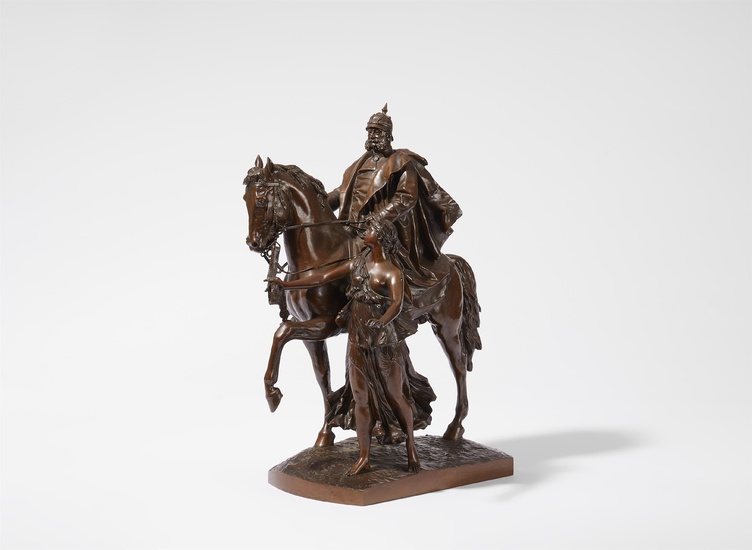Reinhold Begas Emperor Wilhelm I on horseback, guided by an allegory of victory
Reinhold Begas
Emperor Wilhelm I on horseback, guided by an allegory of victory
Finely chased bronze with golden brown patina. Round Gladenbeck foundry mark. H 40, W c. 22, D c. 32 cm.
Berlin, Gladenbeck Foundry, around 1900.
This piece is a rare reproduction of the central equestrian motif from the National Monument to Emperor Wilhelm. The sculptor Reinhold Begas and the architect Gustav Halmhuber erected the 21 metre high monument on Berlin's Schlossfreiheit between 1895 and 1897.
Reinhold Begas was born in Schöneberg on 15th July 1831. As the son of the German painter Carl Joseph Begas, he was the scion of a dynasty of artists spanning several generations and was thus introduced to the fine arts at an early age. Unlike his famous father, however, Reinhold Begas was more interested in sculpture from the outset, so he received his basic training not in his father's workshop but with the sculptor Ludwig Wilhelm Wichmann in Berlin. He began his studies under Christian Daniel Rauch at the Berlin Academy of Art in 1846, which at the time had Johann Gottfried Schadow, one of the greatest sculptors in the history of German art, as its director. Reinhold Begas himself enjoyed his first success with his plaster group "Hagar and Ishmael" and was able to visit Rome from 1856 to 1858 on a scholarship. In the cosmopolitan city, rich in tradition and art, he made the acquaintance of artistic personalities such as Arnold Böcklin, Heinrich Dreber and Anselm Feuerbach and created his marble group "Amor and Psyche" in the style of the Swiss sculptor Ferdinand Schlöth.
Under the influence of his experiences in Rome, not least through his study of the works of Gian Lorenzo Bernini and Michelangelo, Reinhold Begas began to adopt a baroque style that ran counter to the austere classicism that still prevailed at the time. In 1861, he received a call from the still fairly new Grand Ducal Saxon School of Art in Weimar, where he met his Roman acquaintance Böcklin again as a teacher and also got to know Franz von Lenbach. Reinhold Begas took up a teaching position until 1863 and then returned to Berlin. Although there were repeated short stays in Rome and Paris, the Prussian city of Berlin remained the home of the artist, who earned the favour of the Hohenzollerns with his unconcealed pathos and received numerous prestigious commissions from Emperor Wilhelm II. The Kaiser Wilhelm National Monument, unveiled in 1897, was designed by Reinhold Begas together with Gustav Halmhuber in the neo-baroque style; it survived two world wars but was destroyed in the GDR in 1950; only three figures have remained extant.
Sale price
Estimate
Time, Location
Auction House
Reinhold Begas
Emperor Wilhelm I on horseback, guided by an allegory of victory
Finely chased bronze with golden brown patina. Round Gladenbeck foundry mark. H 40, W c. 22, D c. 32 cm.
Berlin, Gladenbeck Foundry, around 1900.
This piece is a rare reproduction of the central equestrian motif from the National Monument to Emperor Wilhelm. The sculptor Reinhold Begas and the architect Gustav Halmhuber erected the 21 metre high monument on Berlin's Schlossfreiheit between 1895 and 1897.
Reinhold Begas was born in Schöneberg on 15th July 1831. As the son of the German painter Carl Joseph Begas, he was the scion of a dynasty of artists spanning several generations and was thus introduced to the fine arts at an early age. Unlike his famous father, however, Reinhold Begas was more interested in sculpture from the outset, so he received his basic training not in his father's workshop but with the sculptor Ludwig Wilhelm Wichmann in Berlin. He began his studies under Christian Daniel Rauch at the Berlin Academy of Art in 1846, which at the time had Johann Gottfried Schadow, one of the greatest sculptors in the history of German art, as its director. Reinhold Begas himself enjoyed his first success with his plaster group "Hagar and Ishmael" and was able to visit Rome from 1856 to 1858 on a scholarship. In the cosmopolitan city, rich in tradition and art, he made the acquaintance of artistic personalities such as Arnold Böcklin, Heinrich Dreber and Anselm Feuerbach and created his marble group "Amor and Psyche" in the style of the Swiss sculptor Ferdinand Schlöth.
Under the influence of his experiences in Rome, not least through his study of the works of Gian Lorenzo Bernini and Michelangelo, Reinhold Begas began to adopt a baroque style that ran counter to the austere classicism that still prevailed at the time. In 1861, he received a call from the still fairly new Grand Ducal Saxon School of Art in Weimar, where he met his Roman acquaintance Böcklin again as a teacher and also got to know Franz von Lenbach. Reinhold Begas took up a teaching position until 1863 and then returned to Berlin. Although there were repeated short stays in Rome and Paris, the Prussian city of Berlin remained the home of the artist, who earned the favour of the Hohenzollerns with his unconcealed pathos and received numerous prestigious commissions from Emperor Wilhelm II. The Kaiser Wilhelm National Monument, unveiled in 1897, was designed by Reinhold Begas together with Gustav Halmhuber in the neo-baroque style; it survived two world wars but was destroyed in the GDR in 1950; only three figures have remained extant.



